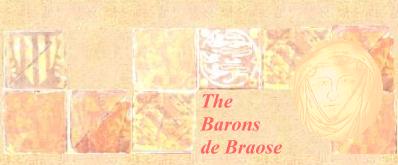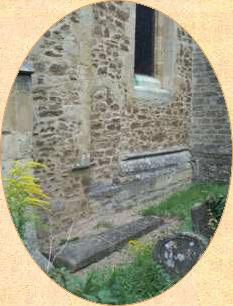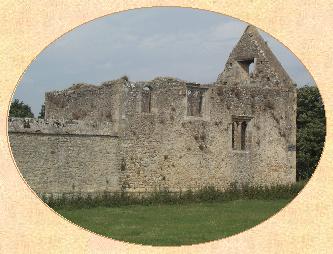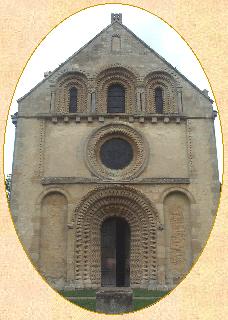
The
Recluses
 William
de Braose and Maud de Saint Valery produced as many as seventeen
children. Several had remarkable lives but two were among the
enigmas of their age and their stories are even more intriguing
today. Loretta and Annora were achoresses. Each renounced her
aristocratic privileges to become a recluse, permanently walled
up in a small cell attached beneath the eaves of
a church. (18.1)
William
de Braose and Maud de Saint Valery produced as many as seventeen
children. Several had remarkable lives but two were among the
enigmas of their age and their stories are even more intriguing
today. Loretta and Annora were achoresses. Each renounced her
aristocratic privileges to become a recluse, permanently walled
up in a small cell attached beneath the eaves of
a church. (18.1)
Loretta must have been
a young girl when she married Robert fitz Parnel, heir of the
Beaumont family and Earl of Leicester. Robert was a famous warrior
who went crusading with King Richard and defended Normandy for
both Richard and King John. Nonetheless, married life in the
Midlands was more peaceful for Loretta than in the Welsh Marches
where she was raised. Loretta
probably saw Robert infrequently before his death in 1204 and
they had no children. She therefore settled into widowhood with
her dower of one third of her husband's land, notably Hungerford,
and the gifts provided by her father, including Tawstock in Devon
and Couvert in Normandy. The dowager Countess of Leicester was
still an exceptionally wealthy and well-connected woman.
No doubt there were many
ambitious men hoping to become Loretta's second husband. This
prospect receded, however, with the ruin of her father. Her lands
were taken into the king's hands and she probably sought refuge
in Paris. If so, she saw her father die there and in the company
of her brother, Bishop Giles, became a friend of Stephen Langton,
the exiled Archbishop of Canterbury. After her return to England
in 1214, King John compelled Loretta to swear on the Gospels
that she had not remarried and would only do so with the king's
consent. Having met this condition she regained her dower lands.
 In
about 1221 Loretta's life underwent a stark transformation but
her choice was not marriage. Instead she secluded herself for
life in a tiny cell attached to Saint Stephen's church at Hackington,
outside Canterbury. She had a small, private room from which
she could observe the daily ritual at the altar through a window
cut into the church wall. Another outer room also had a window
through which she could communicate with her visitors.
People came to her from throughout
Europe. The Recluse of Hackington was both a religious curiosity
and, it was believed, a source of spiritual advice untainted
by worldy corruption. A new shrine for Saint Thomas Becket was
established at Canterbury Cathedral in 1220. Many Canterbury
pilgrims would have made their way to nearby Hackington.
In
about 1221 Loretta's life underwent a stark transformation but
her choice was not marriage. Instead she secluded herself for
life in a tiny cell attached to Saint Stephen's church at Hackington,
outside Canterbury. She had a small, private room from which
she could observe the daily ritual at the altar through a window
cut into the church wall. Another outer room also had a window
through which she could communicate with her visitors.
People came to her from throughout
Europe. The Recluse of Hackington was both a religious curiosity
and, it was believed, a source of spiritual advice untainted
by worldy corruption. A new shrine for Saint Thomas Becket was
established at Canterbury Cathedral in 1220. Many Canterbury
pilgrims would have made their way to nearby Hackington.
Only
a hint of Loretta's daily business, besides her religious devotions,
is traceable. She intervened to gain a pardon for an outlawed
woman who had given shelter to a fugitive from justice and also
for a man from Shropshire who had killed another by misadventure.
Most impressively Loretta is named with the Ardeacon of Canterbury,
Simon Langton, the brother of the Archbishop, as a primary influence
responsible for overcoming hostility to the new Franciscan religious
order. Saint Francis of Assisi had just developed his stigmata
at this time but his eccentric followers were in danger of being
declared heretics. Loretta and Simon Langton welcomed the Franciscans
to Canterbury. Their advocacy helped provide for the first Franciscan settlement in England before the order
was fully established at Greyfriars.
 Loretta's
sister Annora married Hugh de Mortimer. Annora had been imprisoned
at Bristol during King John's persecution of their family and
released in 1214. In the same year Hugh succeeded his father
and took control of Wigmore and a large marcher barony. He died
in 1227, leaving Annora with no children but a comfortable income
and her mother's property at Tetbury and Hampnett.
Loretta's
sister Annora married Hugh de Mortimer. Annora had been imprisoned
at Bristol during King John's persecution of their family and
released in 1214. In the same year Hugh succeeded his father
and took control of Wigmore and a large marcher barony. He died
in 1227, leaving Annora with no children but a comfortable income
and her mother's property at Tetbury and Hampnett.
She
was a benefactor of Godstow
Abbey near Oxford.
Godstow was connected with her mother's family of Saint Valery
and Loretta's sister Flandrina was a nun there who rose to become
the abbess. (18.2) It would not have been unusual
for a widow like Annora to take the veil in a nunnery with her
sister. She might also have chosen to join her sister Margaret
at Aconbury, the priory founded for the souls of her mother and
father. (18.3) But in 1232 Annora chose an anchorite
cell attached to Saint
Mary's Church at Iffley,
near Oxford.
 King
Henry III made annual deliveries of oaks from the forest of Shotover
to Annora, the Recluse of Iffley, for her fire. His other gifts
included a sack of grain, a robe and timbers for her cell. Part
of the furniture of an anchorite cell was the grave slab under
which the recluse knew she would eventually be buried. Her cell
would be her resting place for all time and this was true for
Annora. Her slab still lies at the spot where her cell was built
and a filled hole in the wall is evidence of her window into
the church.
King
Henry III made annual deliveries of oaks from the forest of Shotover
to Annora, the Recluse of Iffley, for her fire. His other gifts
included a sack of grain, a robe and timbers for her cell. Part
of the furniture of an anchorite cell was the grave slab under
which the recluse knew she would eventually be buried. Her cell
would be her resting place for all time and this was true for
Annora. Her slab still lies at the spot where her cell was built
and a filled hole in the wall is evidence of her window into
the church.
The King's gifts to Annora
were no longer recorded after 1241, the last year in which she
is known to have been alive. Loretta reached a very old age despite
her frugal existence as an achoress for perhaps fifty years.
She is last seen in a letter from Simon de Montfort, written
under the name of the king in the significant year 1265. He asked
Loretta to describe the roll of the Steward of England, one of
the hereditary duties of the earldom of Leicester which Simon
had inherited. Loretta's reply is unknown and Simon de Montfort
died at the battle of Evesham that same year.
Gerald of Wales described
William de Braose and his wife Maud as particularly religious
people. This may seem like mere flattery, considering the violence
of their lives in the Welsh Marches. The evidence of their daughters'
lives, however, indicates that Gerald might have spoken the truth.

back
to text

back to text

back to text

back to text
 The Recluses |
||||||||
Loretta must have been a young girl when she married Robert fitz Parnel, heir of the Beaumont family and Earl of Leicester. Robert was a famous warrior who went crusading with King Richard and defended Normandy for both Richard and King John. Nonetheless, married life in the Midlands was more peaceful for Loretta than in the Welsh Marches where she was raised. Loretta probably saw Robert infrequently before his death in 1204 and they had no children. She therefore settled into widowhood with her dower of one third of her husband's land, notably Hungerford, and the gifts provided by her father, including Tawstock in Devon and Couvert in Normandy. The dowager Countess of Leicester was still an exceptionally wealthy and well-connected woman. No doubt there were many ambitious men hoping to become Loretta's second husband. This prospect receded, however, with the ruin of her father. Her lands were taken into the king's hands and she probably sought refuge in Paris. If so, she saw her father die there and in the company of her brother, Bishop Giles, became a friend of Stephen Langton, the exiled Archbishop of Canterbury. After her return to England in 1214, King John compelled Loretta to swear on the Gospels that she had not remarried and would only do so with the king's consent. Having met this condition she regained her dower lands.
Only a hint of Loretta's daily business, besides her religious devotions, is traceable. She intervened to gain a pardon for an outlawed woman who had given shelter to a fugitive from justice and also for a man from Shropshire who had killed another by misadventure. Most impressively Loretta is named with the Ardeacon of Canterbury, Simon Langton, the brother of the Archbishop, as a primary influence responsible for overcoming hostility to the new Franciscan religious order. Saint Francis of Assisi had just developed his stigmata at this time but his eccentric followers were in danger of being declared heretics. Loretta and Simon Langton welcomed the Franciscans to Canterbury. Their advocacy helped provide for the first Franciscan settlement in England before the order was fully established at Greyfriars.
She was a benefactor of Godstow Abbey near Oxford. Godstow was connected with her mother's family of Saint Valery and Loretta's sister Flandrina was a nun there who rose to become the abbess. (18.2) It would not have been unusual for a widow like Annora to take the veil in a nunnery with her sister. She might also have chosen to join her sister Margaret at Aconbury, the priory founded for the souls of her mother and father. (18.3) But in 1232 Annora chose an anchorite cell attached to Saint Mary's Church at Iffley, near Oxford.
The King's gifts to Annora were no longer recorded after 1241, the last year in which she is known to have been alive. Loretta reached a very old age despite her frugal existence as an achoress for perhaps fifty years. She is last seen in a letter from Simon de Montfort, written under the name of the king in the significant year 1265. He asked Loretta to describe the roll of the Steward of England, one of the hereditary duties of the earldom of Leicester which Simon had inherited. Loretta's reply is unknown and Simon de Montfort died at the battle of Evesham that same year. Gerald of Wales described
William de Braose and his wife Maud as particularly religious
people. This may seem like mere flattery, considering the violence
of their lives in the Welsh Marches. The evidence of their daughters'
lives, however, indicates that Gerald might have spoken the truth.
|
||||||||